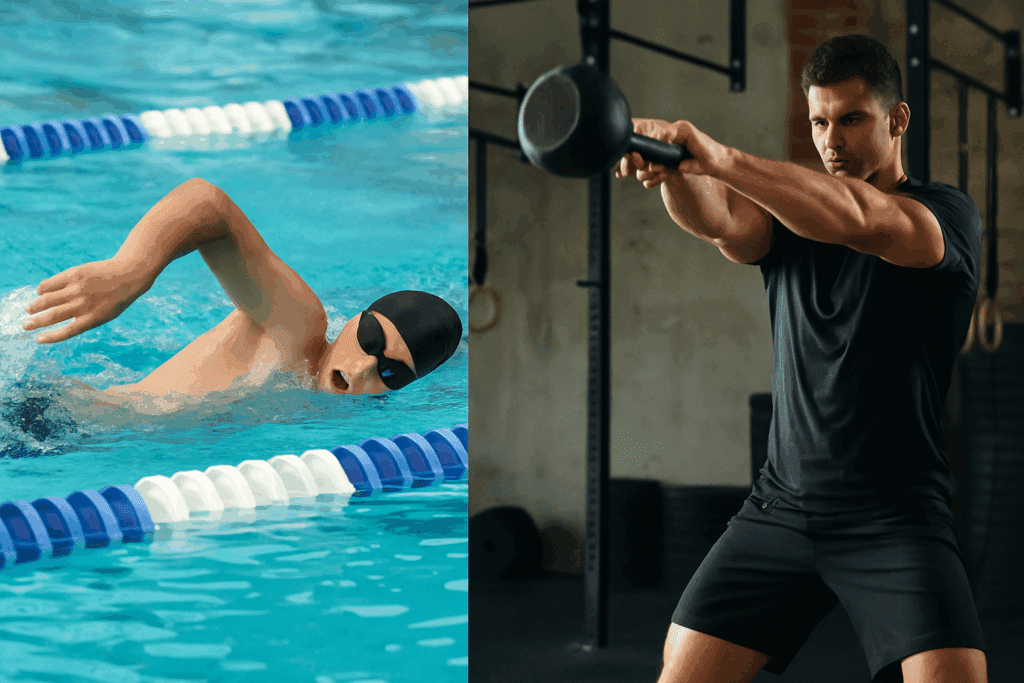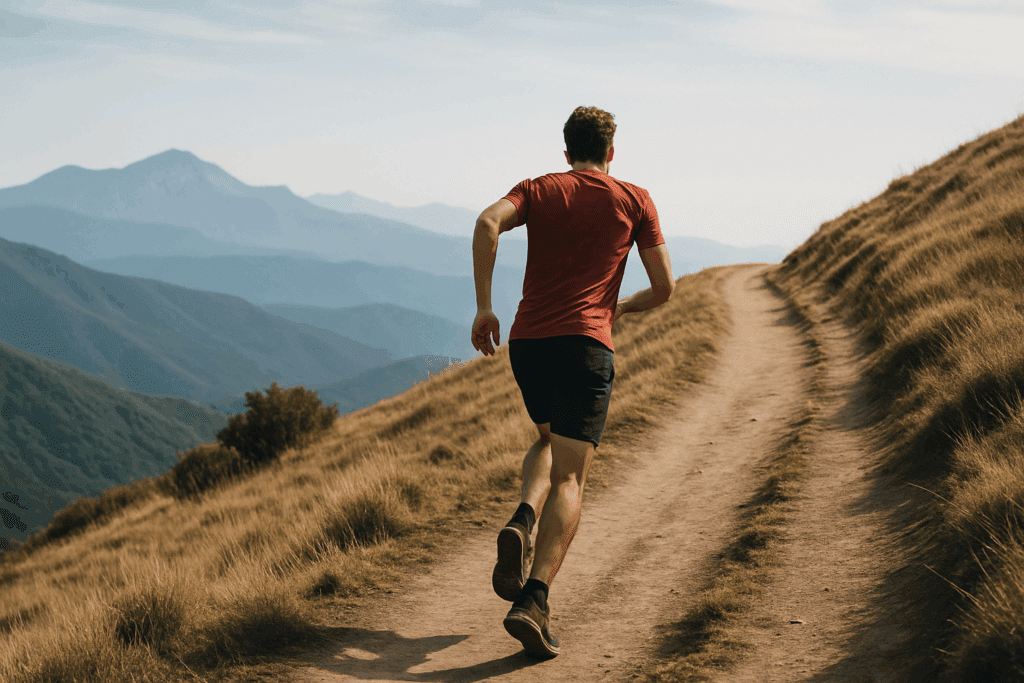Introduction: Understanding the Foundation of Performance
The pursuit of peak physical performance isn’t merely about pushing harder or spending more hours in the gym. It’s about training smarter. Athletes, fitness enthusiasts, and health-conscious individuals alike benefit from understanding the balance between aerobic and anaerobic systems. Knowing when and how to engage each energy system is essential for enhancing stamina, building muscle power, and avoiding overtraining. Whether you’re training for a marathon, a triathlon, or simply aiming to boost your fitness, incorporating a variety of aerobic and anaerobic exercise examples into your routine is foundational.
You may also like: How to Increase Stamina and Endurance Naturally: Smart Training Tips and Nutrition Habits That Support Cardiovascular Fitness
What often gets overlooked in the discussion of fitness is the science behind how our bodies generate energy. Aerobic exercise relies on oxygen to fuel sustained, moderate-intensity activity, making it ideal for improving cardiovascular health and endurance. On the other hand, anaerobic exercise taps into energy reserves without using oxygen, supporting high-intensity, short-duration efforts like sprinting or heavy lifting. Each method provides unique benefits, and mastering their application can elevate training outcomes. But to fully leverage their potential, it is crucial to understand the nuances of both systems and how they interact with different training modalities.
This article delves into the distinctions, complementary roles, and real-world applications of aerobic and anaerobic training. It also explores whether common activities, such as swimming, fall into the aerobic category and how nuanced understanding can guide personalized training strategies. With science-backed insight and practical examples, we provide a comprehensive exploration of how to naturally enhance performance and stamina.

Defining Aerobic and Anaerobic Exercise
At its core, the difference between aerobic and anaerobic exercise lies in how the body produces energy. Aerobic exercise, derived from the Greek word “aerobios” meaning “living in air,” refers to physical activity that depends on the presence of oxygen. During this type of exercise, the body uses oxygen to convert carbohydrates and fats into usable energy, primarily ATP (adenosine triphosphate). Because of its reliance on oxygen, aerobic exercise tends to be lower in intensity and longer in duration, such as jogging, cycling, and swimming.
Anaerobic exercise, by contrast, operates independently of oxygen. The term “anaerobic” means “without air,” and these exercises are characterized by short bursts of high-intensity activity. During anaerobic activity, the body relies on the ATP-phosphocreatine system and anaerobic glycolysis for quick energy. Because these energy systems are limited, anaerobic exercises can only be sustained for short periods—generally under two minutes. Examples include sprinting, high-intensity interval training (HIIT), powerlifting, and certain forms of plyometrics.
While these systems appear distinct, they often work together during real-world activities. For instance, a soccer player may rely on aerobic capacity to sustain movement throughout a 90-minute match but tap into anaerobic stores during sprints or explosive plays. Understanding how these systems interact allows athletes to tailor their training for sport-specific demands. Additionally, balancing both systems can help mitigate fatigue, reduce injury risk, and promote long-term physical development.

Aerobic and Anaerobic Exercise Examples in Practice
When considering how to structure a workout routine, one of the first decisions is the balance between aerobic and anaerobic elements. For those aiming to build cardiovascular endurance, activities like running at a steady pace, swimming laps, or participating in a cycling class provide effective aerobic training. These exercises challenge the heart and lungs over extended periods, improving circulation and increasing the efficiency of oxygen transport throughout the body.
Is swimming an aerobic exercise? This is a common question, and the answer largely depends on the intensity and duration of the session. When performed at a steady pace for a prolonged time, swimming is indeed an excellent form of aerobic exercise. It engages multiple muscle groups, enhances respiratory capacity, and is particularly joint-friendly due to its low-impact nature. However, swimming can also be anaerobic if performed as sprints or part of a high-intensity circuit.
On the anaerobic side, activities like sprint intervals, resistance training with heavy weights, and short-distance rowing require maximal effort in short bursts. These types of exercises deplete stored glycogen and place considerable demand on fast-twitch muscle fibers. Incorporating exercises such as box jumps, battle ropes, and Olympic lifts can dramatically improve strength, speed, and muscular coordination. Including anaerobic exercise in a weekly routine helps improve the body’s ability to handle lactic acid buildup, a crucial factor in delaying fatigue during competition.

Physiological Benefits of Aerobic Training
The benefits of aerobic exercise extend far beyond improved endurance. Engaging in regular aerobic activity enhances cardiac efficiency by increasing stroke volume and lowering resting heart rate. Over time, this reduces the workload on the heart and supports overall cardiovascular health. In addition, aerobic exercise has been shown to improve lipid profiles, lower blood pressure, and enhance glucose metabolism, contributing to a reduced risk of metabolic syndrome.
From a neurological perspective, aerobic activity stimulates the production of brain-derived neurotrophic factor (BDNF), a protein associated with cognitive function and mental clarity. This makes aerobic training not only a boon for physical health but also for mental well-being. Moreover, engaging in rhythmic, repetitive movement during aerobic activity often triggers a meditative effect, which can reduce stress and improve mood. For individuals dealing with anxiety or depression, consistent aerobic exercise can be a key component of a holistic treatment plan.
Metabolically, aerobic exercise increases mitochondrial density, enabling cells to produce energy more efficiently. This adaptation improves energy levels and supports sustained performance over time. Whether you’re preparing for a long hike, a cycling tour, or just aiming to feel more energetic during the day, developing aerobic capacity is essential. These physiological changes also make aerobic training an excellent foundation for more advanced or sport-specific conditioning.

Physiological Benefits of Anaerobic Training
Anaerobic training, though often more intense and shorter in duration, plays a vital role in performance development. One of its primary benefits is the enhancement of muscular strength and power. By engaging fast-twitch muscle fibers, anaerobic exercises such as sprinting or resistance training promote hypertrophy and neuromuscular efficiency. This makes movements more explosive and improves reaction time in athletic settings.
Anaerobic exercise also increases the body’s ability to tolerate and buffer lactic acid, a byproduct of anaerobic metabolism. Athletes who regularly incorporate anaerobic intervals into their training are often able to push harder and recover faster during competition. Furthermore, anaerobic activity has been shown to boost resting metabolic rate due to the afterburn effect, or excess post-exercise oxygen consumption (EPOC). This means the body continues to burn calories long after the workout has ended, which can support fat loss and metabolic health.
From a hormonal perspective, anaerobic training stimulates the release of anabolic hormones such as testosterone and growth hormone. These hormones contribute to tissue repair, muscle growth, and improved body composition. For aging adults, resistance-based anaerobic training can help counteract age-related muscle loss (sarcopenia) and maintain bone density, both of which are crucial for long-term health and mobility. Incorporating anaerobic exercise into a training regimen provides a powerful complement to the endurance benefits of aerobic work.

Integrating Aerobic and Anaerobic Workouts for Optimal Performance
Creating a well-rounded training program involves striking the right balance between aerobic and anaerobic modalities. Depending on your goals—whether it’s increasing overall stamina, building muscle, losing fat, or enhancing sport-specific performance—this balance will vary. One popular and effective approach is periodization, where training is broken into phases that emphasize different energy systems. For instance, a runner may spend several weeks focusing on base-building aerobic runs before introducing anaerobic speed intervals as race day approaches.
Cross-training is another method that naturally incorporates both systems. For example, combining a long-distance bike ride (aerobic) with short sprints or hill climbs (anaerobic) in the same session can yield comprehensive cardiovascular and muscular benefits. Group fitness classes like boot camps and circuit training often alternate between aerobic and anaerobic intervals, allowing participants to train multiple systems simultaneously. This form of mixed training improves energy system efficiency, promotes muscle balance, and keeps workouts mentally engaging.
When programming for endurance, it is important not to neglect strength training. While aerobic training enhances cardiovascular function, anaerobic training builds the muscular resilience necessary for prolonged effort. For instance, a triathlete may swim (aerobic), perform sprint intervals on the bike (anaerobic), and lift weights to support muscular balance and injury prevention. Integrated training plans that thoughtfully incorporate aerobic and anaerobic elements often yield the most sustainable and effective results.
Is Swimming an Aerobic Exercise? A Closer Look
Returning to a frequently asked question—is swimming an aerobic exercise? The answer is nuanced. Swimming is typically considered an aerobic activity, especially when done at a consistent pace over an extended duration. It enhances cardiovascular capacity, promotes full-body coordination, and burns calories efficiently. Because it engages multiple large muscle groups in a rhythmic pattern, it meets many of the criteria for effective aerobic training.
However, swimming can also serve as an anaerobic workout. Sprint intervals, underwater breath-hold sets, and high-intensity swim drills demand explosive effort and engage the anaerobic energy system. Competitive swimmers often train both systems within the same session. They may start with aerobic warm-ups and endurance sets, followed by short-distance sprints or resistance-based swimming to build power. This dual nature makes swimming one of the most versatile forms of exercise.
Moreover, swimming is particularly beneficial for those recovering from injuries or managing chronic pain. The buoyancy of water reduces impact on joints, allowing individuals to train intensely without added stress. When structured properly, swimming can provide both the low-impact endurance benefits of aerobic training and the strength-building advantages of anaerobic exercise. Understanding how to manipulate stroke rate, distance, and rest intervals helps tailor swim sessions to target specific energy systems.

Building Endurance Through Strategic Training
Endurance is not solely the ability to go longer—it’s the ability to sustain effort efficiently and recover rapidly. Building endurance requires more than simply logging miles or spending hours in the gym. It involves consistent aerobic conditioning, progressive overload, and the intelligent inclusion of recovery. Incorporating a variety of aerobic and anaerobic exercise examples into a training plan can help prevent plateaus and accelerate gains.
Long-duration aerobic sessions build capillary density, enhance oxygen delivery, and improve metabolic flexibility. Meanwhile, including brief but intense anaerobic intervals forces the body to adapt to greater demands and develop resilience. Alternating these training styles in a weekly schedule challenges the cardiovascular system and the muscles in different ways, resulting in more comprehensive fitness. Importantly, recovery should be treated as an active part of training, not an afterthought. Rest days, proper nutrition, and sleep contribute to the physiological adaptations that enable endurance gains.
Tracking progress through metrics such as heart rate variability, pace per mile, or power output can provide insights into endurance development. Over time, athletes often notice that tasks that once felt challenging become manageable, indicating improvements in aerobic capacity and muscular efficiency. Combining scientific training principles with real-world application allows individuals to sustainably increase endurance and reduce the likelihood of burnout or injury.
Frequently Asked Questions (FAQ): Aerobic and Anaerobic Exercise
1. How can understanding energy systems improve sport-specific training? Understanding how aerobic and anaerobic systems function allows athletes to align their workouts with their sport’s physiological demands. For example, a long-distance cyclist would benefit more from aerobic conditioning that improves stamina and fat oxidation, while a sprinter must focus on anaerobic power and lactic threshold tolerance. Tailoring training in this way not only prevents overtraining but also maximizes adaptation and performance. Incorporating aerobic and anaerobic exercise examples that simulate real competition scenarios enhances movement efficiency and fatigue resistance. This strategic application of energy systems is key for elite-level athletic preparation.
2. How does altitude affect aerobic and anaerobic exercise differently? At higher altitudes, oxygen levels are reduced, placing additional stress on the aerobic system. Athletes training in such conditions often experience improvements in red blood cell production, which boosts aerobic performance upon returning to sea level. However, anaerobic efforts are less dependent on oxygen, so short bursts of intense activity are not as severely affected. To adjust, athletes may include more anaerobic exercise examples such as plyometric drills or sprint circuits during acclimatization periods. Integrating altitude-aware training can provide a competitive edge, especially in endurance events.
3. Can mental fatigue impact aerobic and anaerobic performance differently? Yes, mental fatigue can impact both types of exercise, but the effects vary. Aerobic exercise performance often declines due to reduced motivation and impaired pacing strategies caused by mental exhaustion. Conversely, anaerobic performance may suffer from decreased motor coordination and delayed reaction times, particularly in sports requiring quick decision-making. Including mindfulness or cognitive training alongside physical routines helps mitigate these challenges. Whether engaging in steady-state cardio or high-intensity intervals, choosing the right aerobic and anaerobic exercise examples when mentally fatigued can prevent unnecessary setbacks.
4. How can wearable technology support aerobic and anaerobic training? Wearables offer real-time data that help athletes fine-tune their training based on heart rate zones, VO2 max estimates, and recovery indicators. This is particularly useful when alternating between aerobic and anaerobic exercise examples within a single workout. For instance, tracking lactate threshold heart rate can optimize anaerobic intervals, while monitoring consistent heart rate during a long swim can confirm whether the session remained in the aerobic zone. Is swimming an aerobic exercise? With wearables, users can analyze swimming intensity to confirm whether the activity primarily engaged aerobic pathways. These tools increase training precision, especially when paired with individualized programming.
5. How does age influence the effectiveness of aerobic versus anaerobic exercise? As individuals age, there tends to be a natural decline in muscle mass and cardiovascular function. Aerobic activities help maintain heart health and endurance, while anaerobic exercises combat sarcopenia and support bone density. The key is progressive adaptation and recovery. Choosing age-appropriate aerobic and anaerobic exercise examples, such as brisk walking and resistance band work, enables older adults to safely maintain a high level of functional fitness. Lifelong exercise that balances both systems promotes longevity and improved quality of life.
6. What role does sleep play in supporting both aerobic and anaerobic recovery? Sleep is essential for all forms of exercise recovery, but it plays distinct roles in aerobic versus anaerobic adaptation. Aerobic recovery benefits from enhanced parasympathetic activity during deep sleep, which supports cardiovascular repair. Anaerobic recovery relies on the hormonal cascade during REM sleep to rebuild muscle tissue and replenish glycogen. Sleep deprivation can significantly hinder adaptation, particularly in workouts requiring maximal output. Incorporating a consistent sleep routine alongside carefully chosen aerobic and anaerobic exercise examples ensures that the body receives the restoration it needs to progress.
7. Are there specific nutrition strategies for maximizing both aerobic and anaerobic performance? Nutrition timing and macronutrient balance are crucial. For aerobic efforts, carbohydrates consumed a few hours prior help sustain energy, while post-exercise refueling aids glycogen replenishment. Anaerobic performance benefits from higher protein intake to support muscle recovery and growth. Strategic supplements like beta-alanine or creatine can also enhance anaerobic output when paired with high-intensity training. Those asking, “Is swimming an aerobic exercise?” should note that long swim sessions demand the same strategic fueling as long-distance running or cycling to maintain stamina and avoid fatigue.
8. How can exercise variety prevent overuse injuries in aerobic and anaerobic programs? Repeating the same movement patterns can lead to overuse injuries over time, especially in high-volume aerobic training or intense anaerobic routines. Rotating between different aerobic and anaerobic exercise examples provides muscle balance and reduces joint stress. For instance, alternating between swimming, rowing, and elliptical workouts can deliver aerobic benefits while giving certain muscle groups a break. Similarly, shifting from barbell training to resistance bands for anaerobic sessions can lower injury risk. Including cross-training ensures both performance gains and long-term physical sustainability.
9. What is the relationship between breathing patterns and energy system use? Breathing rate and depth offer insight into which energy system is being used. Steady, controlled breathing typically signals aerobic engagement, while rapid, shallow breaths often accompany anaerobic bursts. Athletes can manipulate breathing to influence performance—for example, practicing box breathing during aerobic sessions can improve endurance. Conversely, anaerobic efforts like heavy lifting or sprinting benefit from powerful exhalation to maximize force output. Is swimming an aerobic exercise? It depends partly on how breathing is regulated during strokes; breath control in swimming often reveals whether the effort is primarily aerobic or shifting into anaerobic territory.
10. How might climate and environment shape aerobic and anaerobic capacity? Hot and humid environments challenge thermoregulation, making it harder to sustain aerobic effort due to increased cardiovascular load. Meanwhile, anaerobic efforts can become riskier under extreme heat, as overheating compromises muscle function and elevates fatigue risk. Training indoors or during cooler parts of the day becomes critical in such conditions. Additionally, using environment-specific aerobic and anaerobic exercise examples, such as trail running versus treadmill sprints, helps athletes adapt their routines to their setting. Climate-aware training supports safety while optimizing adaptation, ensuring consistent progression across seasons.
Conclusion: Achieving Sustainable Performance with Balanced Training
For those looking to build a high-performing, resilient body, a deep understanding of aerobic and anaerobic exercise examples is a game changer. Recognizing that both systems contribute uniquely to overall fitness enables smarter, more effective programming. Whether you’re an athlete pushing competitive limits or a wellness-focused individual seeking improved stamina and strength, a balanced training approach delivers measurable, lasting results.
Revisiting the question “is swimming an aerobic exercise” underscores the importance of context in training design. Activities often fall along a spectrum, and learning to manipulate variables such as intensity, duration, and rest intervals empowers individuals to tailor their workouts to specific goals. Swimming, running, cycling, lifting, and HIIT all have their place in a holistic program that develops cardiovascular health, muscular power, and mental resilience.
Incorporating both aerobic and anaerobic elements not only enhances physical performance but also fosters long-term health, cognitive function, and emotional well-being. When aligned with scientific principles, individual goals, and proper recovery, this integrated approach supports sustained progress and peak potential. By applying these insights and embracing variety, anyone can craft a training regimen that is not only effective but also enjoyable and sustainable for life.
Was this article helpful? Don’t let it stop with you. Share it right now with someone who needs to see it—whether it’s a friend, a colleague, or your whole network. And if staying ahead on this topic matters to you, subscribe to this publication for the most up-to-date information. You’ll get the latest insights delivered straight to you—no searching, no missing out.
Further Reading:
What You Need to Know About Anaerobic Exercise
What is the difference between aerobic and anaerobic exercise?

